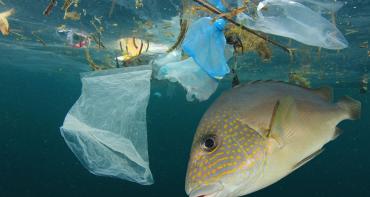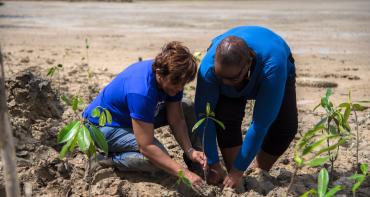╠Ūą─╠Į╗© Blue Charter is highlighting case studies from the Commonwealth and beyond, as part of a series to spotlight best practice successes and experiences.

Share your own case study with us
ŌĆ£There are already a lot of existing tools to become more low-carbon and more energy efficient. But unfortunately the existing tools are made for the bigger ports, and are not so easy to implement for the smaller ports.ŌĆØ Wim Stubbe, PECS Project Coordinator, Port of Oostende
Summary
In 2018, 173 countries adopted a goal to reduce the carbon emissions of global shipping by at least 50 per cent by 2050 (UN Climate Change, 2018). While this effort will focus mainly on changes at the ship level, there is an important role for coastal communities to play in reducing emissions from ports. To this end, several large ports have made ambitious greenhouse gas (GHG) reduction commitments. This case study focuses instead on options for small and medium-sized ports, highlighting the work done through the Ports Energy and Carbon Saving Project (PECS) in Europe.
The issue
CO2 emissions from maritime shipping reached 932 million tons in 2015 ŌĆō 2.6 per cent of total global CO2 emissions and a 2.4 per cent increase from 2013 (Olmer et al., 2017). With the expansion of international trade, shipping emissions are expected to grow by as much as 50-250 per cent by 2050 (IMO, 2015).
While the broader challenge of decarbonising maritime transport focuses mainly on alternative fuels and propulsion technologies for ships, there is an important role for actions taken at the port level. In addition to reducing GHG emissions, these actions can also help reduce the local air pollution created by docked ships, which have harmful health impacts on coastal communities.
Reducing GHG emissions at ports includes both:
- Reducing emissions from ships at berth; and
- Reducing emissions from port operations.
Reducing emissions from ships at berth usually involves offering some type of incentive for lower-emitting ships, such as reduced port fees (see Table: Large ports with environmental port fees), or requiring them to adopt some type of low-carbon practice, such as connecting to shore power while at-berth (e.g. CaliforniaŌĆÖs At-Berth Regulations).1
Reducing emissions from port operations is more varied, but generally involves some combination of:
- Measuring port-level GHG emissions;
- Installing low-carbon power at the port;
- Installing energy-efficient lighting and building retrofits;
- Installing energy-efficient port equipment (e.g. vehicles, linkspans, roll-on/roll-off ships, etc.).

The response
EU Ports Energy and Carbon Saving Project
Several ports around the world are now undergoing major transformations towards low- or zero-carbon emissions. For example, the Port of Rotterdam in the Netherlands has a plan to reduce its emissions by 90 per cent by 2050, while the Port of Oslo recently announced its plan to become zero-carbon (Gerretsen, 2018; Lindeman, 2019).
The EU Ports Energy and Carbon Saving Project (PECS), however, has set its focus on reducing GHG emissions at small and medium-sized (SMS) ports, which often lack the human and financial resources of their larger counterparts. ŌĆ£Small and medium sized ports and marinas donŌĆÖt have enough resources in staff or in money, so for them it is really a challenge to understand what kind of solutions they can implement in order to meet a low-carbon management scheme,ŌĆØ said Wim Stubbe of the Port of Oostende.2
The project is a collaborative effort between 10 partners, including ports, municipalities, companies and universities across the UK, Belgium, France and the Netherlands, which have come together to develop, test and validate various tools, methods and technologies that can help SMS ports reduce their carbon emissions. It will run from 7 December 2017 to 30 June 2021, with a total budget of Ōé¼8.1 million from the EU.
The tools and methods being tested in the project include:
- A methodology and protocol for energy auditing in SMS ports;
- An assessment of the potential for cost-effective renewable energy at SMS ports;
- An assessment of the potential for energy-saving options at SMS ports; and
- A tool to help SMS port mangers identify the best mix of renewables and energy saving options.

The project is also piloting several low-carbon technologies suitable for SMS ports, most of which are currently in place, including:
- A 100 kw medium-sized offshore wind turbine at the Port of Oostende (Belgium) providing electricity to a port terminal (installed June 2018);3
- A liquid natural gas (LNG)-powered linkspan at Portsmouth International Port (UK), which also operates more quickly, resulting in fuel savings for ships (installed March 2018);4
- A waste recycling unit at the Port of Dunkirk (expected to be operational by Q3 2020);5
- An energy pontoon designed and built by a startup company BPS (Blue Power Synergy), with wind generation, solar generation and energy storage at the Port of Oostende (Belgium) (testing in Q3 2020).6
- An IT-enabled Local Energy Market (LEM) platform to enable flexible renewable energy distribution at Omgevingsdienst IJmond (Netherlands) (in development).7
Key lessons learnt
One of the main objectives of PECS is not only to reduce carbon emissions from project partners but also to provide a model and guidance for other SMS ports. To this end, the project conducts feasibility studies on all of the tools, methods and technologies adopted, so that other SMS ports can learn from its experience. Currently, dozens of feasibility studies and guides are available on the PECS website.8
Footnotes
3
4
5
6
7
8
Contacts
European Union Ports Energy and Carbon Savings Project
Wim Stubbe, PECS Project Coordinator, Port of Oostende | E-mail
Sources and further reading
Gerretsen, I. (2018) ŌĆśZero Carbon at Sea? Rotterdam Port Eyes a Greener FutureŌĆÖ. Reuters, 23 October.
IMO (2015) Third IMO Greenhouse Gas Study 2014. London: IMO.
IMO (2018) Port Emissions Toolkit Guide No.1: Assessment of Port Emissions. London: IMO.
ITF (2014) Shipping Emissions in Ports. Paris: OECD.
ITF (2018a) Reducing Shipping Greenhouse Gas Emissions Lessons From Port-Based Incentives. Paris: OECD.
ITF (2018b) Decarbonising Maritime Transport Pathways to Zero-Carbon Shipping by 2035. Paris: OECD.
Lindeman, T. (2019) ŌĆśOslo Wants to Build the WorldŌĆÖs First Zero-Emissions PortŌĆÖ. Grist, 9 November.
Olmer, M., Comer, B., Roy, B., Mao, X. and Rutherford, D. (2017) Greenhouse Gas Emissions from Global Shipping, 2013ŌĆō2015. Washington, DC: ICCT.
UN Climate Change (2018) ŌĆśWorld Nations Agree to at Least Halve Shipping Emissions by 2050ŌĆÖ. News, 14 April.
Media contact
- Josephine Latu-Sanft Senior Communications Officer, Communications Division, ╠Ūą─╠Į╗©
- +44 20 7747 6476 | E-mail


